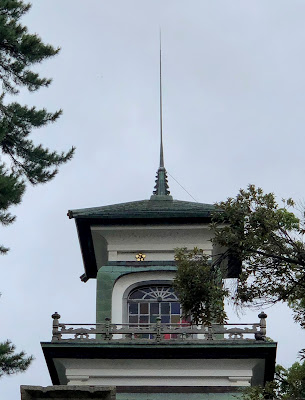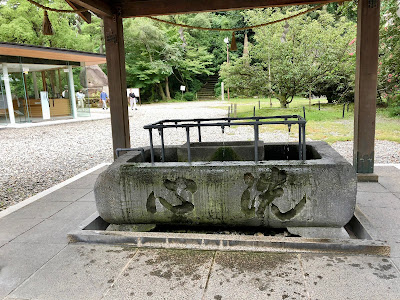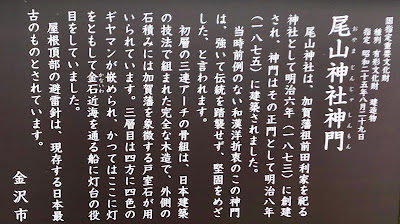 |
| 〒920-0918 石川県金沢市尾山町11-1 Oyama Shrine 11-1 Oyamacho, Kanazawa City, Ishikawa Prefecture 〒920-0918 画像は下記より / This from below ★ |
目次 / Contents
1) 西内惣構跡 / West Inner Enclosed Moats
2) 神門 / Main Gate
A. 概要 / Overview
B. 部分 / Parts
3) 境内 / Precincts
A. 配置 / Layout
B. 手水舎 / Chōzu-ya
C. 拝殿 / Worship Hall
D. 母衣 / Horo
E. 松と梅 / Matsu and Ume
1) 西内惣構跡 / West Inner Enclosed Moats
West Inner Enclosed Moats
I traveled to Kanazawa for 3 nights and 4 days.
About the first day, below.
Today, on the second day, I went sightseeing by myself in the morning, and in the afternoon, I met with my friend, S Chan who lives in Kanazawa, and together we went to the contemporary art museum "KAMU Kanazawa" : ★.
"KAMU Kanazawa" has 6 exhibition spaces in Kanazawa city, so I took a walk around Kanazawa.
Sightseeing before Oyama Shrine, below.
↓
S Chan introduced me to Kamukanazawa, and Oyama Shrine was on my list of places I wanted to visit in Kanazawa.
Oyama Shrine is one of the tourist attractions, and she had already visited several times, but she accompanied me to go with me.
In front of Oyama Shrine, there was a guide board of 'Nishiuchi Sougamae Ruins : 'West Inner Enclosed Moats Ruins'.
While I was walking around Kanazawa, I saw information boards about several 'Sougamae'.
'Sougamae' is a defensive line that surrounds the castle's functional constituent parts (inner hull) with moats, stone walls, and earthworks to the outside (outer hull).
Outside Kanazawa Castle, a total of four Sogamae-bori moats were dug on the east and west sides of the castle.
The waterway in front of Oyama Shrine was part of the 'West Inner Sougamae'
.jpeg) |
| Here English describe about 'Nishiuchi Sougamae' which is 'Nishiuchi City Wall'. |
 |
| Map of Kanazawa Castle Town in Kaga Province, 1668 |
 |
| This shows here the early of Shōwa Period (1926 - 1989). |
2) 神門 / Main Gate
A. 概要 / Overview
私が尾山神社へ行きたかった理由は、神門に興味があり、見たかったからです。
写真も集中して撮ってます。
本殿全体の写真撮影をわすれるほどに...(苦笑)。
 |
| 神門 (シンモン) 日本の神社の門とは思えないデザインです。 いろいろなテーストが混ざり合っています。 だからこそ、興味も湧きました。 Main Gate : Shin-mon The design does not look like the gate of a Japanese shrine. Various tastes are mixed. That's why I became interested. |
The reason I wanted to go to Oyama Shrine was because I was interested in the shrine gate and wanted to see it.
I also concentrated on taking pictures.
So much so that I forgot to take a photo of the entire main shrine... (Wry Smile).
 |
| 境内側から 1875年竣工 3層建て / 高さ約25メートル 国指定重要文化財 From the Precincts 3 Stories / About 25m High National Important Cultural Property |
大塚志良 (オオツカシロウ / ? - ? : 長谷川の弟) により計画され、
長谷川家出入りの大工・津田吉之助(ツダ キチノスケ /1826 または27 - 1889または1890) によって建てられました。
また第2代金沢市長にもなっています。
 |
神門 / Main Gate : Shin-mon.jpeg) |
The Shin-mon was planned by Junya Hasegawa (1843 - 1907) and Shiro Otsuka (?-?: Hasegawa's younger brother).
It was built by Kichinosuke Tsuda (1826 or 27 - 1889 or 1890),
a carpenter who frequented the Hasegawa family.
Three styles of Japanese, Chinese and Western are mixed.
By the way, Junya Hasegawa was one of the people who created and promoted Shokusan-kogyo : Encouragement of New Industry to help the samurai who lost their jobs after the abolition of the domain.
He also became the second mayor of Kanazawa.
B. 部分 / Parts
 |
| 初層 "初層の三連アーチの骨組は、日本建築の技法で組み込まれた 完全な木造建築で、外側の石積みには 加賀藩を象徴する戸室石 (トムロイシ) が用いられています。" 戸室石について→★ / ★ First Storey According to the Guide Board, "The gate's first storey comprise three broad arches, the skeletons of which were built entirely of wood using Japanese architectural techniques. The outer stone facade is made of Tomuro-stone, a type of stone characteristic to construction in the Kaga Domain." |
下記、サイトからの要約
戸室石は金沢産の安山岩で赤と青の色があります。
金沢では石の赤色が普遍的であり、地方色を表わしてきましたが、
青色も用いられてきました。
赤・青の戸室石は、金沢の土木・建築・庭園の材料として色彩を活かされ、高い文化的要素となりました。
Below is a summary from the site, (translated by me)
Tomuroishi-stone is an andesite rock produced in Kanazawa and has red and blue colours.
In Kanazawa, the red colour of the stone is universal and represents the local colour, but blue has been also used.
The red and blue Tomuroishi-stone has been used as a material for civil engineering, architecture and gardens in Kanazawa, and has become a highly cultural element.
 |
| 避雷針 "屋根頂部の避雷針は、 現存する日本最古のものとされています。" (案内板より) Lightning Rod According to the Guide Board, "The lightning rod installed on its roof is the oldest surviving in Japan." |
 |
| 木彫 木彫のデザインも典型的な神社仏閣のものではない ように感じます。 かわいらしい感じです。 Wood Carving I feel that the wood carving design is not typical of shrines and temples. It feels pretty.  梅の花 尾山神社は、藩祖:前田 利家 (マエダトシイエ/ 1539 -1599) を祀る神社として建立されました。 木彫がかわいらしく感じる1つの理由として 前田家(前田氏)の家紋が '梅の花' によるものと思います。 前田 利家は、加賀藩初代藩主(藩祖)であり、 前田家 (前田氏) の祖でもあります。 Ume-no-Hana : Japanese Apricot Flower Oyama Shrine was built as a shrine dedicated to Toshiie Maeda (1539 - 1599), the founder of the domain. I think one of the reasons why wood carvings are pretty is because the Maeda family crest is based on the 'Ume-no-Hana : Japanese Apricot Flower'. Toshiie Maeda was the first lord of the Kaga Domain and the founder of the Maeda Family (the Maeda Clan). 前田家の家紋 : 加賀梅鉢 (カガウメバチ) Maeda Family Crest : Kaga-Umebachi 画像は下記より / This from below |
尾山神社を訪ねたときに疑問に思ったのが、あらこちらに梅の花をあしらったものがあったからでした。
神門の木彫も、本殿を囲むレンガ積 (このセクションの最後の写真) にも、拝殿にも、それらはありました。
後日、写真や資料に目を通しているとき、 金沢市立中村記念美術館 : ★に展示されていた菅原 道真 (845 -903) の掛け軸の絵:
金沢市立中村記念美術館 : ★に展示については下記。
それをきっかけとしてネット検索すると、同様の記事がたくさん見つかりました。
前田家が道真公の子孫であるという歴とした証拠はなく、前田氏は
それを否定する証拠もないのかもしれません。
お殿様が言うのだから、それに反対するものも、いないのでしょう???
前田氏は家紋を菅家の梅鉢紋を用い、'加賀梅鉢'としています。
尾山神社で、何故 '梅の花'が使用されているのかという疑問がとけて、私としてはすっきりした気持ちで、これを書いています。
Ume-no-Hana : Japanese Apricot Flower here and there.
I saw that they were in the wooden carvings of the shrine gate, the brick masonry surrounding the main hall (last photographs in this section), and the worship hall.
Later, when I was looking through the photographs and materials,
I found that Sugawara no Michizane (845 - 903) was an ancestor of the Maeda Clan of the Kaga Domain in the explanation about
Sugawara no Michizane (845 - 903) of a hanging scroll painting
exhibited at the Kanazawa Nakamura Memorial Museum.
About the painting in the Museum, below,
After searching the internet, I found many similar articles.
There is no historical evidence that the Maeda Clan is descended from Sugawara no Michizane, and the Maeda Clan has admitted to being a branch of the Sugawara Clan, the Harada Clan.
There also may be no evidence to deny it.
Since the lord says so, there was no one who opposes it, right? ? ?
Maeda Clan uses the 'Kaga-Umebachi' crest which was the 'Umebachi' of Sugawara Clan crest.
I am writing this with a clear feeling, as I have cleared my doubts as to why Ume-no-Hana (Ume Flower) is used in Oyama Shrine.
3) 境内 / Precincts
A. 配置 / Layout
 |
| 境内の地図 / Map of Precincts: ★ 尾山神社の歴史と由来はここで→★ ❶ 本殿 / Main Hall ❷ 拝殿 / Worship Hall ❸ 神門 / Main Gate ❹ 利家公像 / Toshiie Statue ❺ お松の方像 / O-Matu-no-Kata Memorial Stone ❻ 授与所 / Conferment Place ❼ 金谷神社 / Kanaya Shrine ❽ 東神門 / East Gate ❾ 神苑 / Garden: Shin-en ★画像は下記より / This from below |
B. 手水舎 / Chōzu-ya
 |
| 手水舎 / Chōzu-ya A chōzu-ya is a pavilion where worshipers use chōzu-bachi to purify themselves.  手水鉢 / Chōzu-bachi The pavilion contains a large water-filled basin called a chōzu-bachi. |
C. 拝殿 / Worship Hall
 |
| ❷ 拝殿 拝殿の全体像を撮影しなかったので、 この写真をWikiより借りました。 尾山神社は1873年創建です。 ❷ Worship Hall I borrow this photograph from Wiki because I didn't take a picture of the entire worship hall. Oyama Shrine was founded in 1873. 画像は下記より / This from below ★ |
 |
| 阿吽の狛犬 私は、神社やお寺にある 阿吽 (アウン) の狛犬像や仁王像 (金剛力士像) が好きです。 阿吽の思想が好きだからではないかと思っています。 通常左が吽形 (ウンギョウ) 像で右が阿形 (アギョウ) 像です。 上の写真が、吽形の狛犬、 下の写真が阿形の狛犬です。 Komainu : Lion-dog of A-un Niō statues (Kongorikishi statues) in shrines and temples. I think it's because I like Au-n's ideas. Usually, the left one is the Ungyō statue and the right one is the Agyō statue. The picture above is Ungyō Komainu, The picture below is Agyō Komainu.  阿形の狛犬 この神社の狛犬は伝統的な狛犬よりも細身で、 足も長いです。 西洋の彫刻の影響を受けているように感じます。 Agyō Komainu The Komainu in this shrine are slimmer and have longer legs than traditional Komainu. I feel influenced by western sculpture. |
 |
| 阿形の狛犬、横から Agyō Komainu From the Side |
 |
| 拝殿 梅の花が装飾に使用されている照明が気になって 撮影しました。 拝殿の天井には、3000年に1度しか咲かないと言われる 伝説の花"優曇華(ウドンゲ)" が岩絵具で描かれ、 神社の見どころの1つなのだそうです:★。 ですが、残念ながら私は見ていません。 Worship Hall I took this photograph because I was curious about the lighting with the Ume used for decoration. On the ceiling of the worship hall, the legendary flower "Udonge", which is said to bloom only once every 3000 years, is painted with natural mineral pigments : Iwa-enogu, and is said to be one of the highlights of the shrine. However, unfortunately I haven't seen it. |
"優曇華は、元来、架空の花ですが、のちに、実際の植物、
"Udonge" is originally a fictitious flower, but later, the actual plant, 'Stem-fruit Fig' came to be called "Udonge", and not only the plant but also the egg of Green Lacewings is called 'Flower of Udonge".
D. 母衣 / Horo
 |
| ❹ 利家公像 / Toshiie Statue |
装飾の時代には、膨らんだ形を維持するために内部にフレーム: 骨 (母衣骨 /ホロボネ ・母衣籠 / ホロカゴ) を入れました。
この像は、青年、利家が槍を持って出陣する姿であると思います。
Horo
What appears to be swollen on Toshiie's back is a bag-like object called 'Horo', a decoration attached to the back of the armour worn by Samurai and also to the weapons : ★ only in Japanese.
In the period of ornamentation, frames (Horo-bone / Horo-kago) were put inside to keep the bulging shape.
Maeda Toshiie served as the head of Oda Nobunaga (1534 - 1582)'s Akahoroshu in his youth, and was also a master spearman.
I believe that this statue depicts a young man, Toshiie, going into battle with a spear.
 |
| 母衣の図 / Horo's Picture 画像は下記より/ This from below ★ |
母衣は、当初は武具でしたが、名誉を示す装飾品となりました。
現在その姿を見ると、滑稽に感じるのは、私だけでしょうか?
まあ、母衣だけでなく、時代性があるもの、風習も含めて、のちの時代になると、滑稽に見えるものは多々あると思います。
 |
| 母衣骨・母衣籠 Horo-bone or Horo-kago 画像は下記より/ This from below ★ |
Horo was originally used as a weapon, but it became an ornament to show honour.
Am I the only one who feel it funny when I look at it now?
Well, I think there are many things that look funny in later times, including not only 'Horo', but also things that are relevant to the times and customs.
 母衣の図 / Horo's Picture |
| 画像は下記より/ This from below ★ |
 母衣を武具として着用 画:歌川 国芳 (ウタガワ クニヨシ/ 1798 - 1861) Wearing 'Horo' as a Weapon |
| By Utagawa Kuniyoshi (1798 - 1861) 画像は下記より/ This from below ★ |
 |
| 一の谷の戦い・熊谷直実 『一の谷合戦図屏風』より/ 永青文庫所蔵 (江戸時代) 残念ながら、この絵は、利家ではないのです。 Naomi Kumagai in Battle of Ichinotani From "Ichinotani Battle Screen" Collection of Eisei Bunko Museum (Edo Period) Unfortunately, this picture is not Toshiie. 画像は下記より/ This from below ★ |
E. 松と梅 / Matsu and Ume
利家とは従兄弟にあたります。
彼女は、知性に定評があり、文武に優れ、一族と共に戦いました。
強い決意で知られる松は、多くの政治的および外交的問題の最前線に立ち、前田家の成功にとって極めて重要な役割を果たしました。
特に、関ヶ原の戦い、大坂の陣で徳川家康から前田家を救った功績と自ら人質となって江戸城へゆき、前田家謀反の疑いをはらしました。
彼女は、前田家の救い主として後世に名を残しました。
まつの名前に、松という漢字をあてたのは、後世になってからでしょうか?
前田家の家紋が梅なので、松という漢字は、とてもふさわしく感じます。
 |
❺ お松の方像 / Omatsu-no-Kata Memorial Stone About the Stone in Japanese  おそらく説明板と同様の文面が 彫られています。 Probably the same text in Japanese as the explanation plate is carved. |
Matsu and UmeMaeda Matsu (1547 - 1617) also known as Omatsu-no-Kata was the wife of Toshiie Maeda, the founder of the Kaga Domain.
Matsu and Ume
Maeda Matsu (1547 - 1617) also known as Omatsu-no-Kata was the wife of Toshiie Maeda, the founder of the Kaga Domain.
According to Wiki about Matsu, "Matsu had a reputation for intelligence; she was skilled at both literary and martial arts, she fought alongside her clan. Known for her fierce determination, Matsu was vitally important to the success of the Maeda clan, being at the forefront of many political and diplomatic issues. She was eternalized for saving the Maeda clan from Tokugawa Ieyasu in Battle of Sekigahara and Siege of Osaka."
And also, she herself, decided to go to Edo Castle, as a hostage to clear any suspicion of a possible Maeda rebellion.
She left her name in posterity as the saviour of the Maeda family.
Was it in later times that Kanji character for 松 : pine was applied to the name まつ:Matsu ?
The family crest of the Maeda family is Ume, so the kanji. : 松(pine) feels very appropriate.
In Japan, Ume : 梅 and Matsu: 松 are lucky, as well as lucky in combination, so they are often depicted together.
She left her name in posterity as the saviour of the Maeda family.
Was it in later times that Kanji character for 松 : pine was applied to the name まつ:Matsu ?
The family crest of the Maeda family is Ume, so the kanji. : 松(pine) feels very appropriate.
In Japan, Ume : 梅 and Matsu: 松 are lucky, as well as lucky in combination, so they are often depicted together.
 |
下記、金沢市のサイトより "本殿を囲むレンガ積の玉垣は神門より古く、 異色の神門造営の布石的な存在であったと 考えられます。" (Translated by me) "The brick masonry wall surrounding the main hall is older than the shrine gate, and is thought to have played a role in the construction of the unique shrine gate." |
 |
前田家の家紋 : 加賀梅鉢 Maeda Family Crest : Kaga-Umebachi |
東神門 : ❽ は、金沢城の二ノ丸唐門だった門を移築しました。
それを見逃したのは残念でしたが、次の金沢旅行のお楽しみになります。
次のセクションは、尾山神社の主に庭についてです。
East Gate : ❽ is a relocated gate that used to be the Ninomaru Kara-mon Gate of Kanazawa Castle.
It was a pity that I missed it, but I'm looking forward to my next trip to Kanazawa.
The next section is mainly about the garden of Oyama Shrine.

.jpeg)


.jpeg)





.jpeg)


0 件のコメント:
コメントを投稿